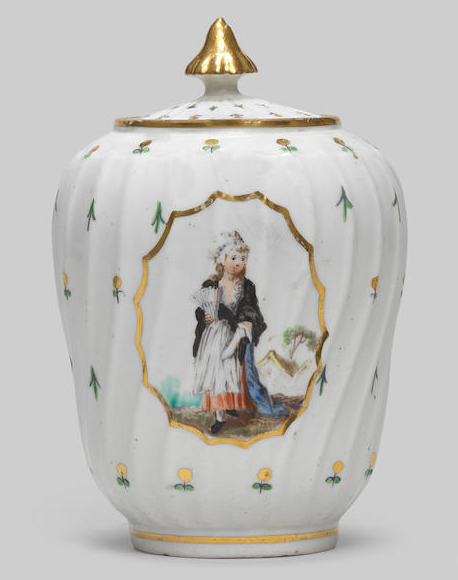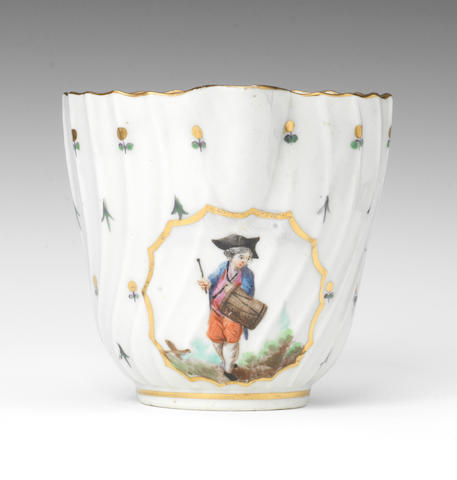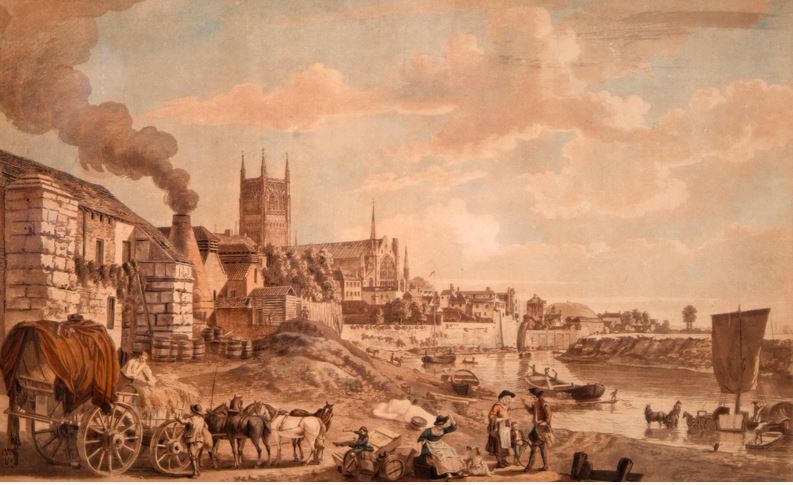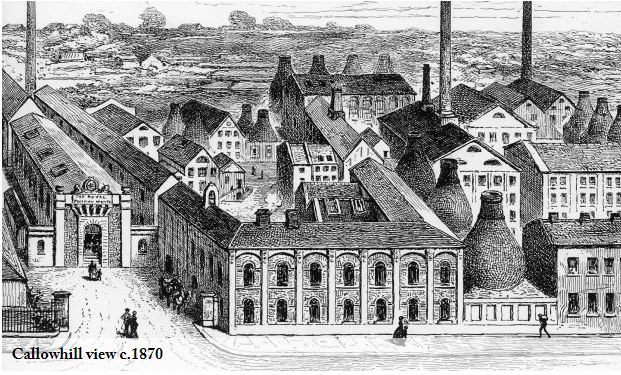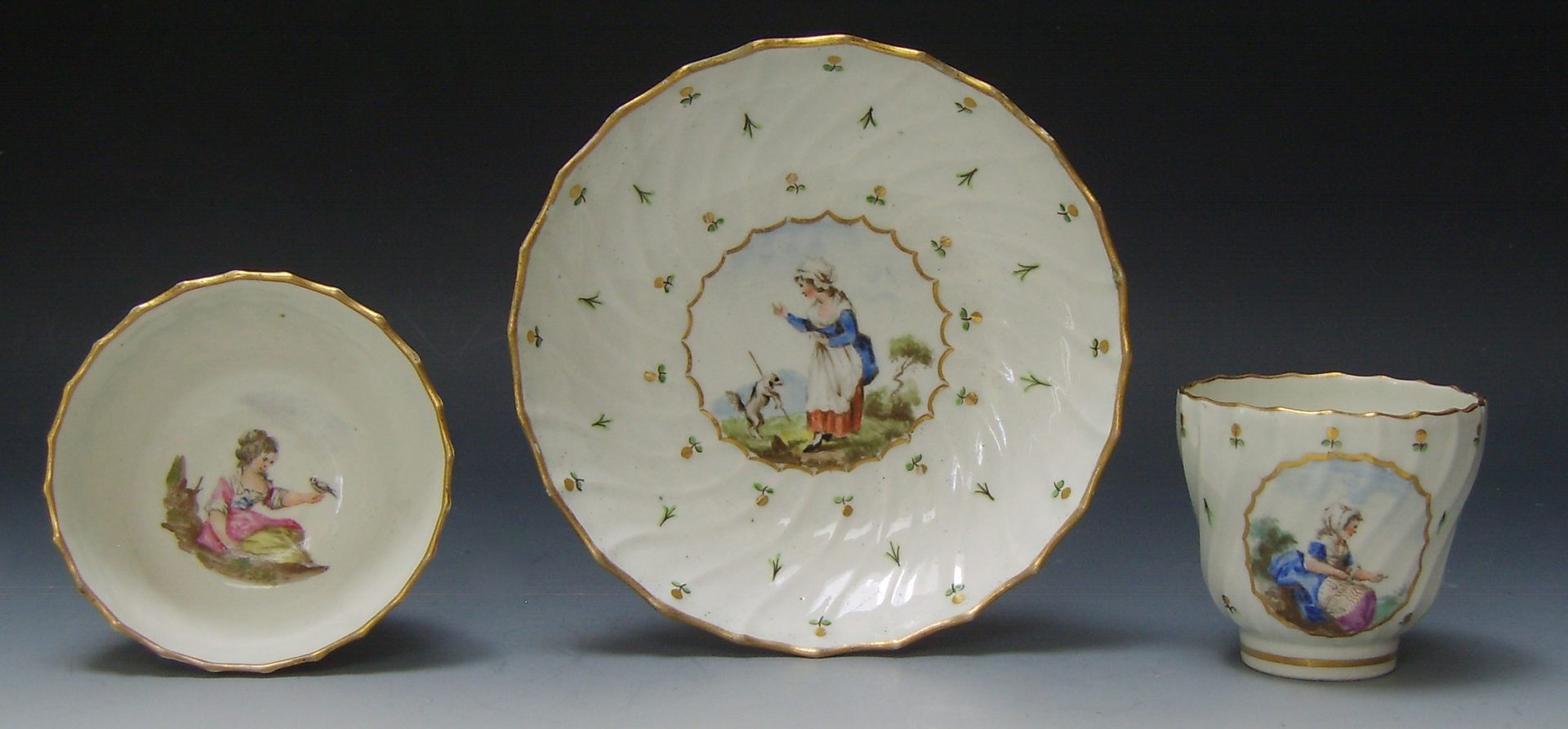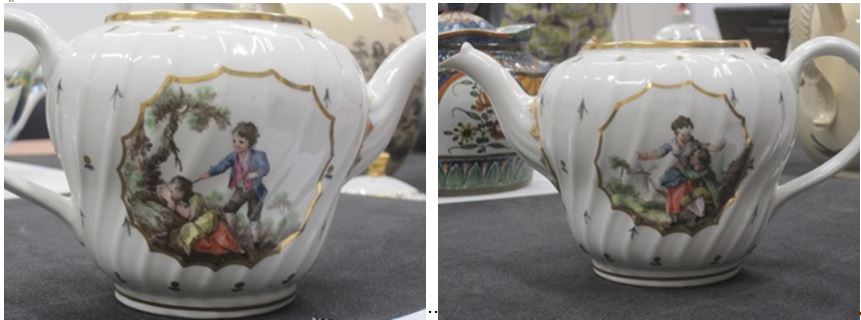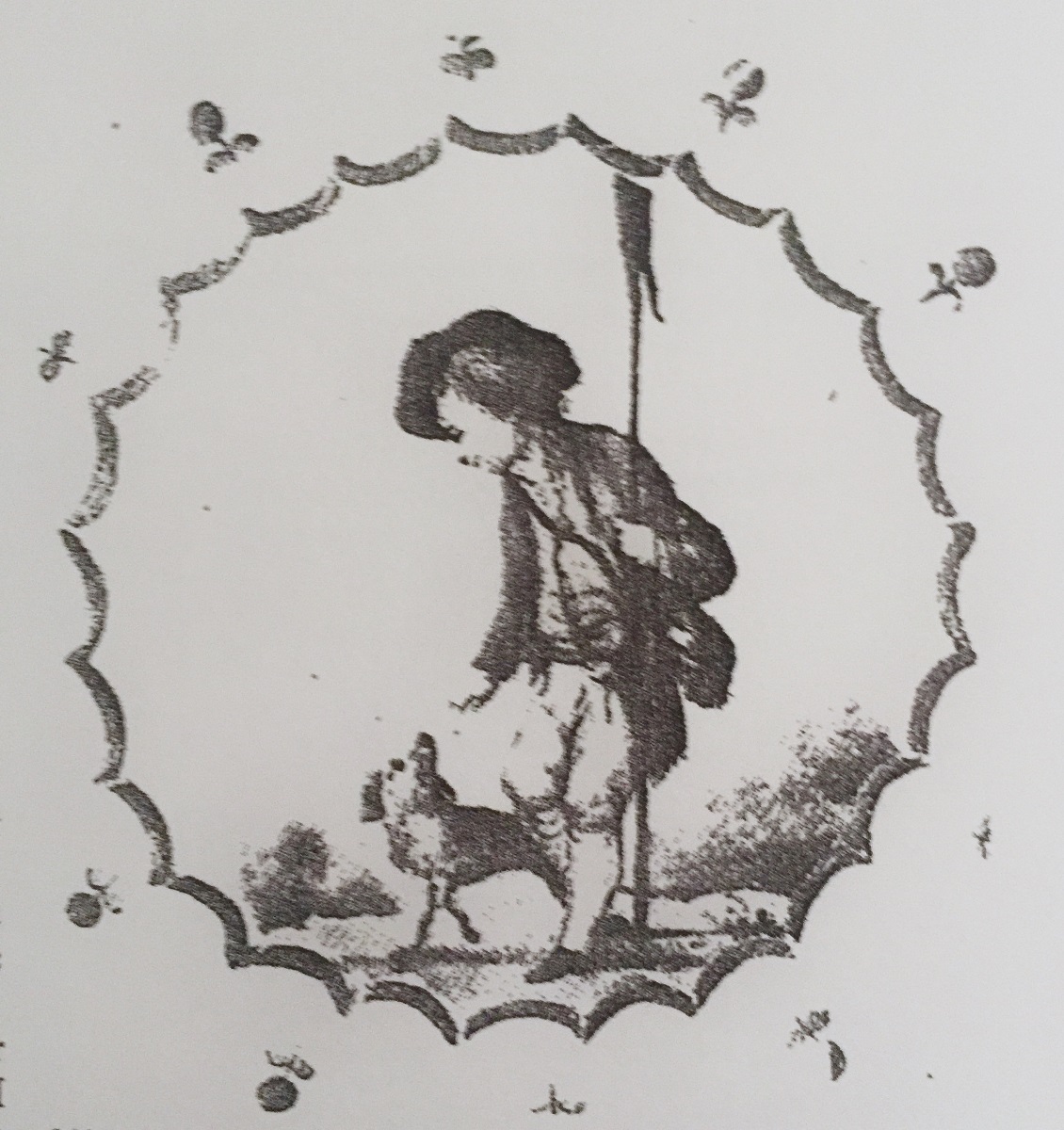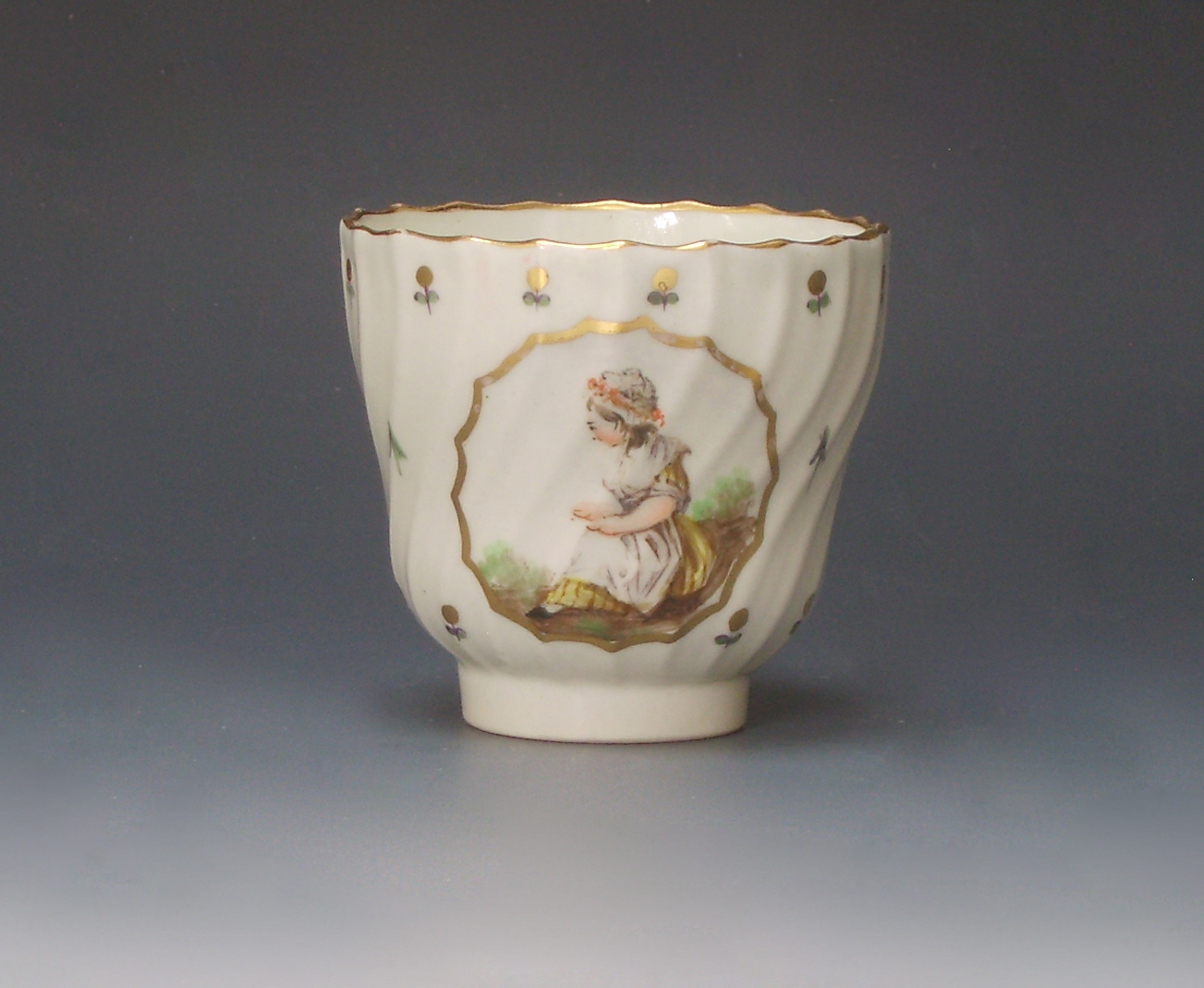1
(Photos 1, 2, 5 and 13 courtesy of Bonhams, London)
4 A 19th-century view of the Royal Worcester Porcelain Works with the Severn River in the distance. On the left is the formal entrance building (once housing the factory showrooms). Today it is part of the Museum of Royal Worcester, displaying the largest collection of Worcester porcelain in the world. The company went into administration in 2008 and closed in 2009.
He mentioned that the Worcester factory had been producing this shape of teawares (referred to as “shanked,” or “shankered,” for its spiral fluting) by at least July, 1790. Following the fashion, Thomas Turner of Caughley soon began producing such shapes as well. Godden pointed out that similarly shaped wasters (fragments and discarded fired objects) were later found in excavations done at the Caughley site that confirmed this point.(iv) He also described tracing the whereabouts of several pieces of this particular Caughley service through a “discriminating London dealer” who had bought them at a country auction sale in 1977, then quickly resold them to other dealers.(v) He managed to buy several of these pieces for his own Reference Collection over the years. A few examples shown here are from this collection and have been auctioned within the past 10 years
(1, 2, 5 a,b and 7 a,b,c).(vi) Although these pieces were at first mistakenly thought to be Flight period Worcester porcelain, Godden recognized their true identity as Caughley, decorated at the Chamberlain establishment. Surviving factory invoices for orders of Caughley blanks in this shape substantiated his attribution. As for the decoration, Godden was convinced it pointed to Fidelle Duvivier’s hand: “The gardener watering flowers [5b] occurs also on a cup in the Luton Museum [6], in a selection of [New Hall] pieces long acknowledged as having been painted by Duvivier,” he wrote.(vii) He discovered another encouraging item among surviving records – here are his own words:
“Now, you must be wondering how or why I linked Duvivier with the Chamberlains at Worcester. The reason is simple and I think convincing. The original Chamberlain records include weekly wage-lists and in one of these lists, that for October 13th 1792 we find the following entry: ‘M. Devia £3-3-0′.
(In his subsequent book on Chamberlain-Worcester Porcelain 1788-1852 [1982], Godden mentioned this fortnight wage record again, but corrected the spelling to ‘M. Deviea’.)
“This entry puzzled me greatly. It was a solitary reference … and the rate of payment was very high when compared with that of the other artists who had been employed for years. … One day, when reading through the other Chamberlain records which abound with quaint spellings, the penny dropped! Surely the name M. [Deviea] was a phonetic spelling of Monsieur Duvivier, written by a clerk who was unfamiliar with the true spelling of the name. … Certainly this highly paid artist [‘Deviea’] does not turn up in any other factories records and there is only this one Chamberlain entry.”(viii)
6 A New Hall cup decorated by Duvivier ca. 1785-90, showing a young gardener with a watering can.
H ca. 6.3 cm. From the collection of the Wardown House Museum & Gallery, Luton, Bedfordshire (inv. L25-225-28). Photo: Pat Preller. See Blogpost 17 (July/August 2018) for more related examples
He did carry out at least one more job for the New Hall factory (or for a private customer), as evidenced by a New Hall service whose pieces all bear the date “1796.”(xiii) Also illustrated in Godden’s first article about these Caughley wares are another cup and saucer, a covered sugar bowl, a bread and butter plate he later acquired from an Australian dealer,(xiv) and the following waste-bowl (8) with a painted scene on the inside showing a girl on a swing in the company of a young lad. This piece is now in an Australian museum collection.
H of bowl 5 cm, Diam. of saucer 13.8 cm. Featured in Albert Amor Autumn exhibition, 2002 (no. 83).
13 “A Caughley spoon tray, circa 1792, of spirally shanked oval form, the centre painted in the style of Fidelle Duvivier with a boy asleep beside a tree, surrounded by regularly spaced green and gold sprigs.
L 17.2cm.”
These questions remain unanswered, but, on the other hand, there is new evidence. Two Caughley dessert plates with familiar Duvivier decoration came on the market in 2014, proving that he had decorated more than just this service at Chamberlains’ in 1792. These plates will be the subject of the next blogpost.
NOTES
(i) See https://www.museumofroyalworcester.org/learning/research/factories/severn-street-factory/ for a detailed history of this period, and https://www.museumofroyalworcester.org/collection-factory/chamberlain/ for a picture of an 1815 Chamberlains vase and cover with an incorporated painted panel showing a view of the Chamberlains porcelain factory.
(ii) Paul Sandby, a contemporary of Gainsborough, was a gifted landscape painter, who was one of the thirty-four founding members of the Royal Academy in 1768. He etched a large number of his paintings and published them as prints. The 1760 original watercolor on which this etching by Sandby was based is in the collection of the Museum of Royal Worcester. See https://www.museumofroyalworcester.org/archive-article/paul-sandby-painting/.
(iii) Geoffrey A. Godden, “Caughley Teawares Painted by Fidelle Duvivier. The Missing Link,” Antique Dealer and Collector’s Guide, August 1978, pp. 67-70
(iv) Ibid., p. 67-68.
(v) Ibid., p. 67. The discriminating dealer was Jean Sewell, who had a shop in a small street off Kensington Church Street, where many porcelain collectors loved to search for treasures (the author included, during the 1980s).
(vi) The tea canister in 1 was auctioned by Bonhams, London, 13 November 2013, lot 210 (sold for £4,750); the jug in 2 was auctioned by Bonhams, London, 3 October 2012, lot 181 (sold for £3,750); and the cup and saucer in 5 a,b was auctioned by Bonhams, London, 2 May 2018, lot 352 (sold for £1,875). See also Note (ix).
(vii) Godden (1978), op. cit., p. 69.
(viii) Ibid., p. 70, and Geoffrey Godden, Chamberlain-Worcester Porcelain 1788-1852 (London: Barrie & Jenkins, 1982), pp. 194-196, with image 1 shown on p. 54. In this work Godden states that Chamberlain began making his own porcelain at the factory in 1791, and stopped decorating Caughley blanks in 1793. But to date no Chamberlain porcelain has been discovered with Duvivier’s decoration.
(ix) Auctioned by Bearnes, Hampton & Littlewood, Exeter, 17 April 2019, lot 596 (sold for £3,100).
(x) Godden (1978), op. cit., pp. 69-70.
(xi) Now in the British Museum. See Charlotte Jacob-Hanson, “Louis Victor Gerverot – Before the Beaker,” Northern Ceramic Society Newsletter (December 2017), vol. 188, pp. 18-28, posted under the author’s name at www.academia.edu
(xii) Godden (1982), op. cit., p. 196. A letter was sent to him on that date, but there are no further details.
(xiii) Charlotte Jacob-Hanson, In the Footsteps of Fidelle Duvivier (Tucson, AZ: Westpress, 2016), p. 71.
(xiv) Godden (1978), op. cit., Fig. 4, Fig. 2, Fig. 7, and Fig. 5, respectively, pp. 68-70. The whereabouts of these objects are unknown. The waste bowl in 8 was shown in Fig. 1. Fig. 5, with a detail from a saucer, is shown as image 10 here.
(xv) Antiques enthusiast Philip Miller began collecting teapots after his wife bought him one as a Christmas present in 1968. He amassed around 2,000 examples, which he later sold to Norwich Castle Museum. The museum was financially helped in acquiring the collection by the Twinings tea company. Together with author Michael Berthoud Philip Miller also wrote An Anthology of British Teapots (Wingham: Micawber Publications, 1985).
(xvi) Auctioned by Bonhams, London, 26 Nov. 2003, lot 332 (sold for £1.553).

